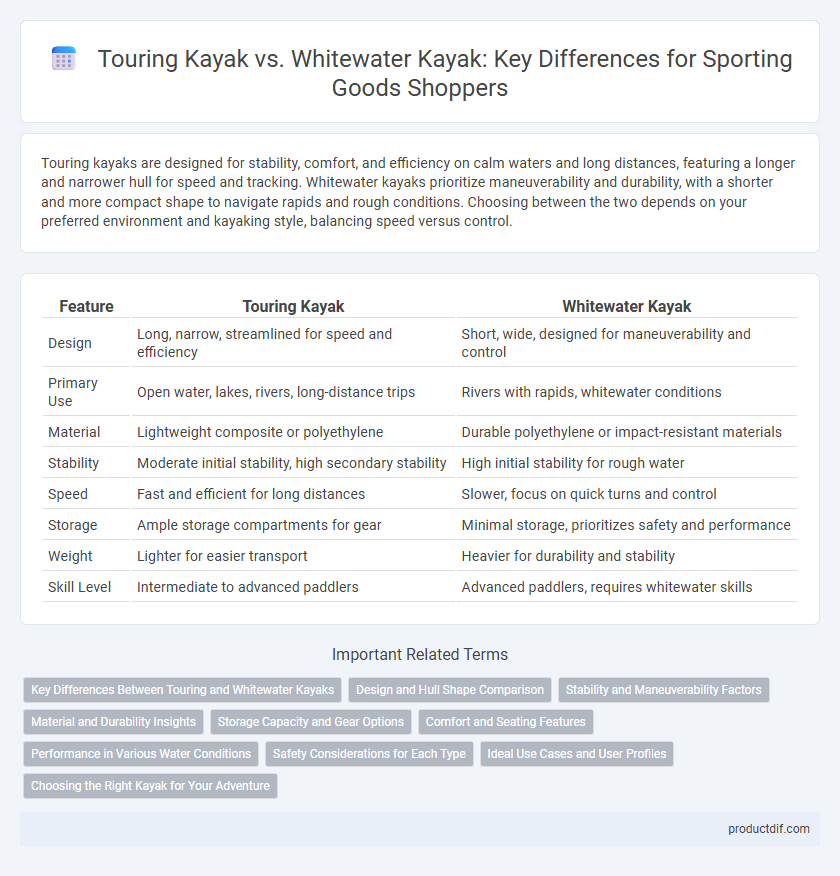Touring kayaks are designed for stability, comfort, and efficiency on calm waters and long distances, featuring a longer and narrower hull for speed and tracking. Whitewater kayaks prioritize maneuverability and durability, with a shorter and more compact shape to navigate rapids and rough conditions. Choosing between the two depends on your preferred environment and kayaking style, balancing speed versus control.
Table of Comparison
| Feature | Touring Kayak | Whitewater Kayak |
|---|---|---|
| Design | Long, narrow, streamlined for speed and efficiency | Short, wide, designed for maneuverability and control |
| Primary Use | Open water, lakes, rivers, long-distance trips | Rivers with rapids, whitewater conditions |
| Material | Lightweight composite or polyethylene | Durable polyethylene or impact-resistant materials |
| Stability | Moderate initial stability, high secondary stability | High initial stability for rough water |
| Speed | Fast and efficient for long distances | Slower, focus on quick turns and control |
| Storage | Ample storage compartments for gear | Minimal storage, prioritizes safety and performance |
| Weight | Lighter for easier transport | Heavier for durability and stability |
| Skill Level | Intermediate to advanced paddlers | Advanced paddlers, requires whitewater skills |
Key Differences Between Touring and Whitewater Kayaks
Touring kayaks feature longer, narrower designs for enhanced speed and stability on flat water and open seas, while whitewater kayaks are shorter and more maneuverable to navigate rapid currents and obstacles. Touring kayaks prioritize comfort and storage capacity for extended trips, whereas whitewater kayaks emphasize durability and control to handle turbulent river conditions. Key differences include hull shape, length, stiffness, and intended use, with touring models optimized for efficiency and endurance, and whitewater models built for agility and impact resistance.
Design and Hull Shape Comparison
Touring kayaks feature longer, narrower hulls designed for speed and stability on flat or open water, allowing efficient tracking and smoother rides over long distances. Whitewater kayaks have shorter, wider hulls with pronounced rocker curves, enhancing maneuverability and responsiveness in turbulent river conditions. The design and hull shape differences directly impact performance, with touring kayaks optimized for endurance and whitewater kayaks for agility.
Stability and Maneuverability Factors
Touring kayaks offer greater initial stability due to their wider hulls, making them suitable for calm waters and long-distance paddling. Whitewater kayaks prioritize maneuverability with shorter, more curved designs, allowing quick turns and agility in turbulent river conditions. Stability in whitewater kayaks is secondary to responsiveness, essential for navigating rapids and obstacles effectively.
Material and Durability Insights
Touring kayaks are typically constructed from high-density polyethylene or composite materials like fiberglass and carbon fiber, providing a balance between lightweight design and durability for long-distance paddling. Whitewater kayaks emphasize impact-resistant materials such as thicker polyethylene to withstand rocks and rough water conditions, prioritizing toughness over weight. The material choice directly affects durability, with touring kayaks favoring rigidity and smooth glide, while whitewater kayaks focus on abrasion resistance and structural reinforcement to endure extreme environments.
Storage Capacity and Gear Options
Touring kayaks offer significantly greater storage capacity with multiple sealed bulkheads and compartments designed for long trips, making them ideal for carrying extensive gear and camping equipment. Whitewater kayaks have minimal storage options, focusing instead on maneuverability and quick access to essential gear like sprayskirts and flotation devices. Gear adaptability in touring kayaks includes mounts for fishing rods and navigation tools, while whitewater kayaks prioritize safety equipment storage optimized for rapid retrieval during turbulent conditions.
Comfort and Seating Features
Touring kayaks prioritize comfort with adjustable padded seats, high backrests, and ample legroom designed for extended paddling sessions. Whitewater kayaks feature compact, snug seating systems with reinforced foam and thigh braces to ensure secure control and stability in turbulent waters. Both kayak types utilize ergonomic designs tailored to their specific environments, enhancing comfort through specialized seating configurations.
Performance in Various Water Conditions
Touring kayaks excel in flatwater and calm coastal conditions, offering superior tracking, stability, and efficiency for long-distance paddling. Whitewater kayaks perform best in turbulent rivers, rapids, and fast-moving streams, providing enhanced maneuverability, durability, and control in rough water. Choosing between the two depends on water conditions, with touring kayaks optimized for endurance and speed, while whitewater kayaks prioritize agility and resilience in challenging environments.
Safety Considerations for Each Type
Touring kayaks offer enhanced stability and storage capacity, making them safer for long-distance paddling and unpredictable weather conditions. Whitewater kayaks prioritize maneuverability and rapid response, essential for navigating fast-moving rivers but requiring advanced skills to maintain control and avoid capsizing. Proper safety gear, including helmets and personal flotation devices, is crucial for both, with whitewater kayaking demanding more specialized protective equipment due to higher risk levels.
Ideal Use Cases and User Profiles
Touring kayaks are designed for long-distance paddling on calm waters, ideal for travelers seeking efficient, stable performance during extended adventures and exploring open lakes, rivers, or coastal areas. Whitewater kayaks cater to adrenaline enthusiasts navigating rapid currents and challenging river obstacles, offering enhanced maneuverability and durability for experienced paddlers engaged in whitewater rafting or extreme river sports. Users prioritizing speed and comfort typically favor touring kayaks, while those focused on agility and ruggedness choose whitewater kayaks for their dynamic, technical demands.
Choosing the Right Kayak for Your Adventure
Touring kayaks offer enhanced stability and storage capacity, making them ideal for long-distance paddling on calm waters and extended trips. Whitewater kayaks prioritize maneuverability and durability to navigate fast currents and rough rapids effectively. Selecting the right kayak depends on your adventure goals, water conditions, and skill level to ensure safety and optimal performance.
Touring kayak vs Whitewater kayak Infographic

 productdif.com
productdif.com